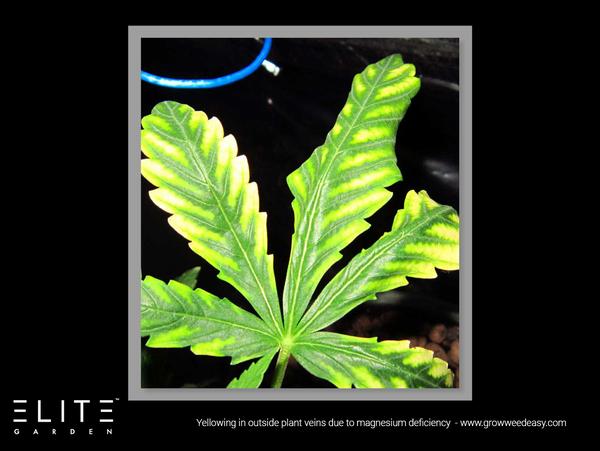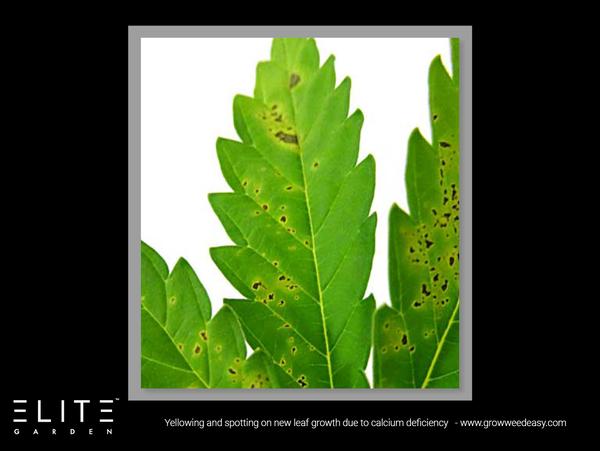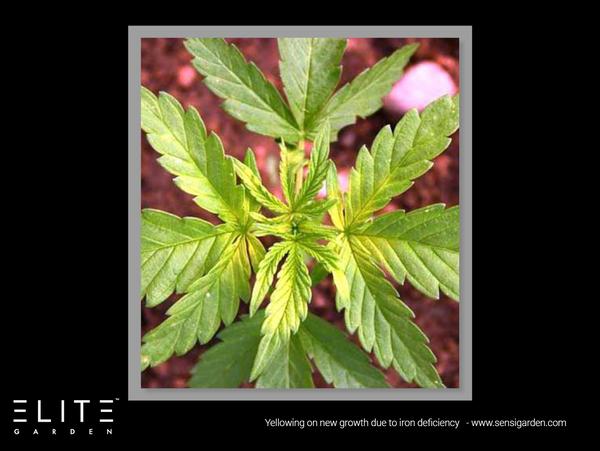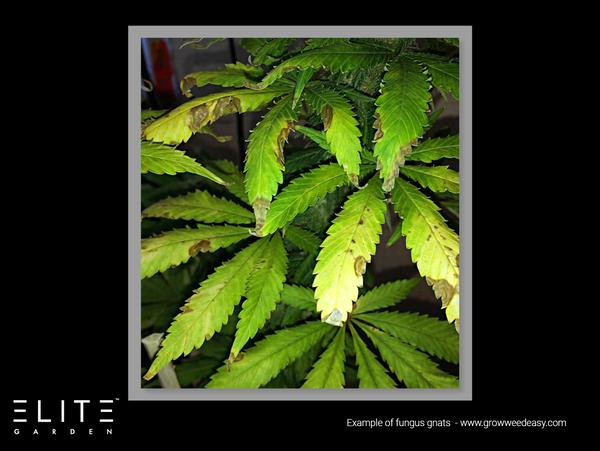Dr. NPK of Elite Garden Wholesale takes through some potential causes of leaf yellowing in cannabis.

The following is an article produced by a contributing author. Growers Network does not endorse nor evaluate the claims of our contributors, nor do they influence our editorial process. We thank our contributors for their time and effort so we can continue our exclusive Growers Spotlight service.
Disclaimer
This article has been republished with permission from Elite Garden Wholesale. The original article can be found here.
Yellowing: Some Causes, and What it Means for your Grow
Hi Guys, Dr. NPK here. People can be green with envy, red with anger (like when my football teams lose!), but most people don’t like to be… yellow? As growers, that’s the most important color we hope to not see! Leaf yellowing is a very vague term that can mean a variety of things to different people. This article is dedicated to helping you understand yellowing: why it occurs, what some potential causes are, and methods you can use to determine the cause.
What Causes Yellowing?
Unfortunately, diagnosing yellowing is extremely difficult. It’s difficult to quickly diagnose issues in your grow due to the sheer number of variables involved. In order to definitively conclude that a given variable is causing the problem, two separate trials must be identical except for the variable being tested. When solving an issue in a living environment, this is often impractical or impossible to do. Below are some of the more well-known reasons that yellowing can occur.
pH Range. In my personal opinion, incorrect pH is one of the most common mistakes people make in their grows. Many growers test the pH of their sumps, but fail to test the runoff pH as well. If there is a significant difference between the two pH’s, it’s likely that something is going awry in your medium/soil. Remember that your ideal pH is between 5.8 and 6.3.

Nitrogen Deficiency. In general, there are many nutrient deficiencies that can cause yellowing. By far and away, the most common lacking macronutrient that causes yellowing is nitrogen. Nitrogen is huge in veg because it promotes healthy leaves. Additionally, because nitrogen is a mobile macronutrient, a nitrogen deficiency will appear first in older leaves as they turn yellow, curl, and die off. Nitrogen has a wide pH tolerance as well, and we make sure to include plenty of concentrated nitrogen it in our Elite Base Nutrient A and Elite CalMag.
Do be careful, however. Nitrogen toxicity is a real thing. Symptoms of nitrogen toxicity include:
- Darker leaves
- Weak stems
- Stunted growth
- A “claw look” to the leaves.
If you’ve ruled out a nitrogen deficiency as your cause of yellowing, it’s time to look at other nutrient deficiencies.

Magnesium Deficiency. One of the common symptoms of a magnesium deficiency is a yellowing of leaves (go figure). Like a nitrogen deficiency, one of the signs is the location of the yellowing. Magnesium is a mobile element, so the plant will ration out its small supply of magnesium to the newer leaves towards the top, where the new growth is. Thus, if you see yellowing towards the bottom of your plants (amidst the older leaves) that are present outside of the veins, consider that a magnesium deficiency might be a possible cause.

Calcium Deficiency. I’ve mentioned this before, but calcium deficiencies are concerning in large part due to calcium’s role in building the cell wall. Calcium behaves extremely different from magnesium, despite being in close in proximity on the periodic table. A calcium deficiency will yield yellow new or younger leaves. This is because calcium is an immobile element, and, as a result, the calcium ion is locked into older leaves and cannot move freely. Thus, leaves will grow in inherently yellow.

Iron/Micronutrient Deficiencies. I chose to lump these together, but basically your cannabis plants require a wide variety of micronutrients and iron to ensure proper growth. Iron is a vital immobile element, so yellowing will first appear in the newer leaves, as with calcium. In general, it is rare to have other micronutrient deficiencies if you are in the right pH and you’re applying the appropriate micronutrients on a regular schedule.

Diseases/Bugs. Another potential cause of yellowing is biological in origin; diseases and pests can cause yellowing! Bud rot and fungus gnats, to name a few, are potential causes for yellowing in plants. Ultimately, any stress on the plant, even something as simple as too much heat, can cause yellowing of the plant. If you eliminate the chemical/nutrient culprits, then it’s clear that the problem is an environmental stressor or pest.

Remedies to Yellowing
Identifying the source of the yellowing is half of the battle! You’re nearly there! The next step is treating the problem.
Obviously, pH adjustment is basically self-explanatory. Use your favorite pH up/down to get to the correct pH. If your media is going bad, switch it out for some fresher material, or get some microbes to help you out.
For nutrient deficiencies, especially those unrelated to N-P-K, take a peek inside your reservoir. Do you see any precipitate (typically in the form of white, solid stuff)? If so, you may be experiencing a nutrient lockout. Nutrient lockout means that the ions in your sump are reacting with one another to make insoluble salts that just chill at the bottom of your reservoir. If you’re getting yellowing and you see a bunch of solid stuff in your tank that you didn’t add intentionally, chances are that nutrient lockout is preventing the contents of your sump from being delivered to the plant! Make sure you are mixing individual nutrients slowly and completely.
Also, consider supplementing your nutrients with a CalMag supplement like Elite CalMag to help supply a variety of secondary nutrients. This will likely help you clear up a variety of nutrient deficiencies one fell swoop. The convenience of using a supplement like this is that it saves you time on “diagnosing” the issue. Instead, you have a blanket solution.
Lastly, if you have an environmental stressor or pest… address that problem first, silly!
Closing Thoughts
Yellowing is a difficult issue to remedy in your grow. It is always worthwhile to take the time to ensure that your pH is within the correct range, your plant has plenty of secondary nutrients and that you are mixing you nutrient correctly to avoid making insoluble salts.
10 Best Gift Ideas for Cannabis Connoisseurs and Growing Aficionados (2022)
December 7, 2022Developing and Optimizing a Cannabis Cultivation System
December 14, 2021Dealing with Insomnia: How Can CBD Help?
December 10, 2020Your Guide to Sleep and CBD
December 7, 2020
Do you want to receive the next Grower's Spotlight as soon as it's available? Sign up below!
Resources:
Want to get in touch with Elite Garden Wholesale? They can be reached via the following methods:
- Website: https://www.elitegardenwholesale.com/
- Email: info@elitegardenwholesale.com

Do you have any questions or comments?

About the Author
Dr. NPK has been in the chemical formulating business for over 9 years. With a Bachelors in chemistry from UCLA and a Ph.D. in chemistry from UC Irvine, he has always had a passion for chemical formulation. Over the past several years, his focus has narrowed towards the research and development of products that are optimized for cannabis. He assisted in the development of the Elite Nutrient line and takes great pride in the products he created and uses himself. He has made it his mission to cut through all the pseudoscience available on the web and to educate readers on the science behind growing top-shelf bud.